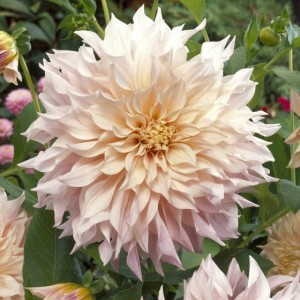 Last week I was considering dahlia selections, because I want to plant lots of them in my front border come spring. Dazzled by the sizes, colors and configurations of the available dahlias, I was especially struck by one, ‘Café au Lait’. The catalog quoted a description from Brides.com that characterized its color as “creamy pink, blush, peach, ivory, champagne and dusty rose.” “Champagne” is simply a fancy word for a beige shade that garden merchandisers often call by another French moniker, “café au lait”. In this case, the individual who named the dahlia when it was introduced back in 1967 opted for evoking coffee over alcohol.
Last week I was considering dahlia selections, because I want to plant lots of them in my front border come spring. Dazzled by the sizes, colors and configurations of the available dahlias, I was especially struck by one, ‘Café au Lait’. The catalog quoted a description from Brides.com that characterized its color as “creamy pink, blush, peach, ivory, champagne and dusty rose.” “Champagne” is simply a fancy word for a beige shade that garden merchandisers often call by another French moniker, “café au lait”. In this case, the individual who named the dahlia when it was introduced back in 1967 opted for evoking coffee over alcohol.
What color is “café au lait” or milky coffee? It depends how much milk you like in your brew. The classic recipe for the French coffee drink suggests equal parts of espresso and milk, but generally most things described as “café au lait” are beige or pale tan—more milk than coffee.
When the term is used to describe flower color, vendors, journalists and gardeners take more than a little bit of latitude. The petals of a café au lait-colored flower may combine peach, pale yellow, mauve, or rose tones, in addition to beige. In some, the beige may be only a whisper or an undertone. Sometimes café au lait tints only emerge as petals age.
Be that as it may, café au lait is fashionable, and I always like to stay on top of horticultural fashion. It appears that café au lait-colored flowers are the frequent blooms of choice for cutting-edge bridal bouquets and indoor arrangements. They combine well with white or cream colored flowers and greens. Some sources suggest that they are also useful for arrangements going to people who are not traditional recipients of floral offerings.
No matter what is going on with florists’ flowers, my interest was piqued on the topic of café au lait in the garden.
The ‘Café au Lait’ dahlia that started my quest is a beautiful thing, with blooms that may be six to ten inches wide. I think ten inch flowers only occur under ideal conditions, but six is entirely possible. The colors vary widely according to the quality of the photographic reproduction and the light, but the flowers clearly have peachy-yellow-beige in their coloration at some points between opening and dropping from the plant. This chameleon-like ability to change hues seems to happen to most café au lait-colored blooms. One mature plant may, in fact, boast many different colors among the flowers in various stages of aging.
In the world of roses, one variety was actually christened ‘Café au Lait’ back in 1993. It is a hybrid tea and the HelpMeFind online listing describes the color as “cream coffee, coffee buff”. Though the hybrid tea rose has more actual coffee color than most other flowers of similar description, the petals have distinct peach tints, making for a very pretty overall effect. The ‘Café au Lait’ rose is an interesting example of what can happen when a breeder stirs the genetic soup. Its parents were a pair of hybrid teas: ‘Just Joey’, an apricot rose bred in New Zealand, and the French ‘Vol de Nuit’, with purple petals.
I am very partial to the extremely variable ‘Distant Drums’ rose, bred in America by Dr. Griffith Buck of Ames, Iowa. One catalog vendor described its color as “a tan-mauve blend [that] transforms colors by the day from red in the unopened stage to yellowish when fully open.” That sounds awful, but the rose itself is quite beautiful and more than a little unusual. I grow it in my garden and it has the vigor for which Buck roses are famous, which adds to its charms.
Dahlias and roses seem to predominate in the café au lait flower world, but they are not alone. Strawflowers or xerochrysum bracteatum, are generally available as seed mixes for home gardens, and some of the plants bear pale café au lait-colored flowers. Yellow strawflowers may age to that shade and since they are often used for dried arrangements, the color remains.
Oak leaf hydrangea—Hydrangea quercifolia—bears flowers that start out white, age to pink, and eventually take on a café au lait color, but most people prefer the flowerheads when they are white or pink.
The café au lait flowers remind me a little bit of old, sepia-tinted photographs, so I suppose that they are at once nostalgic and modern. If this describes your garden, then a dash of milky coffee might fit in nicely.
